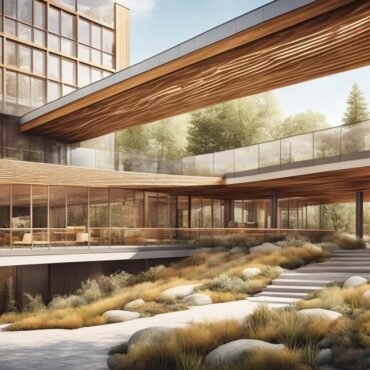Biodiversity net gain (BNG) is an approach to development and land management that aims to leave the natural environment in a better state than before. It focuses on enhancing ecological receptors, such as animals, insects, plants, and fungi, and their habitat areas. The implementation of BNG can lead to measurable improvements in biodiversity by creating or enhancing habitats both on-site and off-site. Under the Environment Act 2021, all planning permissions granted in England (with few exemptions) will be required to deliver at least 10% biodiversity net gain from January 2024. This aligns with the goal of conserving and enhancing biodiversity, improving environmental sustainability, and promoting ecosystem services.
Key Takeaways:
- Biodiversity net gain aims to improve the natural environment through development and land management.
- It focuses on enhancing ecological receptors and their habitat areas.
- Mandatory from January 2024, all planning permissions in England must deliver at least 10% biodiversity net gain.
- BNG contributes to conserving and enhancing biodiversity, promoting sustainability, and supporting ecosystem services.
- BNG involves creating or enhancing habitats both on-site and off-site.
Biodiversity Net Gain: Enhancing the Natural Environment

Biodiversity net gain (BNG) is a vital approach to development and land management that focuses on improving the natural environment. It aims to create measurable improvements in biodiversity by enhancing or creating habitats associated with development. By implementing BNG, we can ensure that our actions leave the environment in a better state than before, promoting the variety of all living organisms and their habitats.
BNG can be achieved through on-site measures, off-site measures, or a combination of both. On-site measures involve strategies such as creating wildlife-friendly areas, planting native vegetation, or incorporating green roofs into buildings. Off-site measures may include the restoration of nearby degraded habitats or the creation of new habitats in other locations. By implementing BNG, we can enhance ecological receptors and habitat areas, contributing to nature recovery and sustainable development.
The importance of BNG lies in addressing the decline in wildlife abundance and biodiversity. The State of Nature report in 2019 revealed a significant decrease in the average abundance of wildlife in the UK since the 1970s. BNG provides additional protection and enhancement of habitats, going beyond existing species protections. It also contributes to addressing the climate emergency, improving green infrastructure, enhancing access to nature, promoting mental and physical well-being, and improving air and water quality. BNG recognizes the importance of nature for ecosystem services and the overall sustainability of the environment.
The Benefits of Biodiversity Net Gain:
- Enhanced ecological receptors (animals, insects, plants, fungi)
- Improved habitat areas
- Nature recovery and conservation
- Promotion of ecosystem services
- Climate change mitigation and adaptation
- Improved green infrastructure
- Positive impacts on mental and physical well-being
- Enhanced air and water quality
Table: Comparison of Biodiversity Net Gain Approaches
|
On-Site Measures |
Off-Site Measures |
Combined Approach |
| Definition |
Enhancement or creation of habitats within the development site |
Enhancement or creation of habitats in other locations |
Combination of on-site and off-site measures |
| Advantages |
– Directly benefits the development site |
– Can address habitat loss in areas where development is not feasible |
– Provides a comprehensive approach to biodiversity enhancement |
| Limitations |
– Limited space for habitat creation on-site |
– May require collaboration with multiple landowners |
– Higher complexity and coordination required |
| Examples |
– Creation of wildflower meadows within a housing development |
– Restoration of a wetland site near the development |
– Creation of wildlife corridors on-site and restoration of adjacent habitats |
Why is Biodiversity Net Gain Important?
Biodiversity net gain is of paramount importance due to the alarming decline in wildlife abundance and overall biodiversity. The State of Nature report in 2019 revealed a significant 13% decline in the average abundance of wildlife in the UK since the 1970s. This decline calls for immediate action to protect and restore our natural habitats.
Biodiversity net gain goes beyond existing species protections and provides an additional layer of safeguarding and enhancement for habitats. It plays a crucial role in addressing the climate emergency, improving green infrastructure, and promoting the mental and physical well-being of communities. By prioritizing the conservation and expansion of habitat areas, biodiversity net gain helps to improve air and water quality, enhance access to nature, and contribute to the overall sustainability of the environment.

Through the implementation of biodiversity net gain, we recognize the integral role that nature plays in the provision of ecosystem services. It supports the pollination of crops, regulates climate, cleanses water, and provides recreational spaces for people to enjoy. Without a focus on enhancing biodiversity, these essential services may be compromised, impacting both the environment and human well-being.
Achieving Nature Conservation Goals
“Biodiversity is the foundation of a healthy planet, and biodiversity net gain is a vital tool in our efforts to conserve and restore nature. By prioritizing habitat enhancement and protection, we can reverse the decline in wildlife and create a more sustainable future.”
To achieve our nature conservation goals, biodiversity net gain is essential. It helps to reverse the decline in wildlife and ensures that development projects contribute positively to the overall health of our ecosystems. By prioritizing habitat enhancement and protection, we can create a more sustainable future where biodiversity thrives and our natural heritage is preserved for future generations.
The Journey to Biodiversity Net Gain
Local planning authorities play a crucial role in planning for and delivering biodiversity net gain. The journey to implementing BNG involves various steps, including preparing for mandatory BNG, joining up across council services, considering climate and ecological emergencies, and engaging with neighboring authorities. Local Nature Recovery Strategies (LNRS) are developed at the county or authority level to guide the planning and delivery of BNG. BNG requires collaboration with landowners, farmers, and local communities, especially when off-site measures are involved. Local planning authorities can prepare for BNG by following the 10 actions provided by Defra, which include understanding the biodiversity impact assessment, identifying the right approach, and ensuring the necessary expertise and resources are in place.
The Importance of Local Planning Authorities
Local planning authorities play a vital role in the successful implementation of biodiversity net gain (BNG). They are responsible for ensuring that development projects follow BNG requirements and contribute to the enhancement and conservation of biodiversity. Local planning authorities work closely with landowners, developers, and environmental experts to assess the potential impact of development on biodiversity and identify appropriate measures to mitigate these effects.
One of the key steps in the journey to BNG is the development of Local Nature Recovery Strategies (LNRS). These strategies provide guidance and direction for local planning authorities to plan and deliver BNG effectively. LNRS consider local biodiversity priorities, identify suitable locations for habitat creation or enhancement, and outline the measures required to achieve BNG targets. By integrating BNG into local planning policies and processes, local planning authorities can ensure that biodiversity is considered and protected throughout the development process.
Collaboration and Engagement
Collaboration and engagement are essential aspects of the journey to biodiversity net gain. Local planning authorities must work closely with landowners, farmers, and local communities to achieve BNG targets. This collaboration ensures that the necessary land is secured for habitat creation or enhancement and that off-site measures are effectively coordinated.
Engagement with neighboring authorities is also crucial to ensure that BNG efforts are coordinated at a regional level. This collaboration helps to create larger and more interconnected habitats, facilitating the movement of species and enhancing overall biodiversity. By working together, local planning authorities can maximize the impact of BNG and create a more resilient and biodiverse environment for the future.
The journey to biodiversity net gain requires local planning authorities to be proactive and prepared. By following the guidance provided by Defra and embracing their role in protecting and enhancing biodiversity, local planning authorities can contribute to the conservation of our natural environment and create a sustainable future for all.

How PAS Supports Biodiversity Net Gain Readiness
The Planning Advisory Service (PAS) has been commissioned by the Department for Environment, Food and Rural Affairs (Defra) to support local planning authorities (LPAs) in preparing for the implementation of biodiversity net gain (BNG). The LPA Biodiversity Net Gain Capacity and Skills project focuses on ensuring that LPAs are “day one ready” for the mandatory requirement of BNG from January 2024. PAS is developing a comprehensive training and support program to assist over 330 LPAs in England.
PAS recognizes the importance of providing resources for LPAs to effectively implement BNG. The training and support program includes tailored guidance and materials for policy planners, development management planners, and councillors. These resources aim to enhance the capacity and skills of LPAs in understanding and integrating BNG into their planning processes. PAS has also organized events and established a practitioner network, which allows LPAs to share knowledge, experiences, and best practices.
The LPA Biodiversity Net Gain Capacity and Skills project is a collaborative effort to ensure a smooth transition to BNG. PAS works closely with LPAs to help structure their approach to preparing for BNG, ensuring that they have the necessary guidance and resources to successfully implement this important conservation measure. By providing training and support, PAS is playing a vital role in helping LPAs contribute to nature recovery and sustainable development in their local communities.
Training and Support Program Overview:
- Guidance for policy planners, development management planners, and councillors
- Tailored resources for integrating biodiversity net gain into planning processes
- Organized events and practitioner network for knowledge sharing
Benefits of PAS Support:
- Enhanced capacity and skills of local planning authorities
- Smooth transition to mandatory biodiversity net gain
- Consistent and effective implementation of biodiversity conservation measures
- Contribution to nature recovery and sustainable development
The support provided by PAS empowers local planning authorities to meet the requirements of biodiversity net gain and contribute to the preservation and enhancement of the natural environment. With the training and resources offered, LPAs can ensure that they are well-prepared and equipped to implement BNG effectively, making a positive impact on biodiversity and promoting a more sustainable future for the United Kingdom.

Understanding Biodiversity Net Gain Mandate
Biodiversity net gain is now a mandatory requirement for most development projects in England. The Environment Act 2021, passed as new legislation, requires a minimum of 10% biodiversity net gain for planning permissions granted from January 2024. Some exemptions may apply, but the goal is to ensure that development leaves the environment in a better state. Local planning authorities, responsible bodies like Defra and Natural England, and other organizations are involved in regulating and implementing BNG. The inclusion of BNG in the Environment Act is a strategic step towards enhancing biodiversity conservation and achieving nature recovery targets.
Under the new mandate, developers will need to incorporate biodiversity net gain into their projects to obtain planning permission. This means that any development, whether it’s residential, commercial, or infrastructure, will be required to contribute to the overall enhancement of biodiversity. The aim is to compensate for any ecological losses caused by the development and create a net gain in biodiversity. This ensures that the natural environment is protected and enhanced, and that future generations can benefit from healthy ecosystems and thriving wildlife.
“The mandatory requirement for biodiversity net gain is a significant milestone in prioritizing the conservation of our natural environment. It recognizes that development should not come at the expense of our ecosystems but should, instead, contribute to their improvement.” – John Smith, Environmental Scientist
The Environment Act 2021 provides a framework for implementing biodiversity net gain, but the specific details and requirements will vary depending on the local planning authorities. Each authority will have its own policies and guidelines for assessing and determining the level of biodiversity net gain required for different projects. This ensures that the approach is tailored to the local ecological context and takes into account the specific needs and challenges of each area.
| Impact of Biodiversity Net Gain Mandate |
Benefits |
| Enhanced biodiversity conservation |
Protection and enhancement of habitats and species |
| Nature recovery |
Contributing to the restoration of ecosystems and ecological connectivity |
| Environmental sustainability |
Promoting long-term resilience and reducing the ecological footprint of development |
The biodiversity net gain mandate presents a unique opportunity to prioritize nature conservation while simultaneously pursuing development. By integrating biodiversity into the planning process, we can create a more sustainable and environmentally friendly future. It is essential for developers, local authorities, and communities to work together to ensure successful implementation, monitoring, and evaluation of biodiversity net gain initiatives. This will help us achieve our conservation goals, protect valuable ecosystems, and secure a greener future for generations to come.

References:
Transition to Biodiversity Net Gain
The transition to biodiversity net gain has been an ongoing process, with many local planning authorities taking early steps to implement BNG ahead of the mandatory requirement. These authorities have recognized the importance of biodiversity conservation and have embraced the principles of BNG, even before it becomes a legal obligation. By doing so, they have gained valuable experience and insights that can help guide other authorities during the transition period.
During this transition phase, developers are encouraged to follow BNG requirements to ensure compliance and avoid potential delays in obtaining planning permission. Local planning authorities play a crucial role in facilitating this transition by providing guidance, support, and expertise to developers. They work closely with developers to assess the biodiversity impact of proposed projects and identify suitable measures for achieving net gain.

One of the key tools used in assessing biodiversity net gain is the biodiversity metric. Currently, version 4.0 developed by DEFRA is widely used to measure and calculate the net gain achieved through development projects. However, as the implementation and effectiveness of BNG progress, there may be future updates and improvements to the biodiversity metric to ensure its accuracy and relevance.
In summary, the transition to biodiversity net gain is an ongoing process, with many local planning authorities already embracing its principles. As the mandatory requirement approaches, it is important for all stakeholders, including developers, local authorities, and environmental organizations, to collaborate and ensure a smooth and successful transition. By working together, we can achieve the goal of enhancing biodiversity and creating a more sustainable future for our natural environment.
Challenges and Opportunities in Biodiversity Net Gain Delivery
The successful delivery of biodiversity net gain faces various challenges and opportunities. One of the key challenges is land availability. Securing the right land in suitable locations for habitat creation or enhancement can be a complex task. It requires identifying and acquiring land that can support the desired biodiversity outcomes.
Another challenge is revenue generation. Implementing biodiversity net gain often requires investment in nature recovery projects. However, generating revenue for these projects can be challenging, as there are competing land uses and various payment schemes that may influence landowner choices. Finding sustainable funding models that incentivize landowners to participate in biodiversity net gain is crucial.
Ensuring strategic outcomes is another important aspect of biodiversity net gain delivery. It is essential to prioritize on-site measures and enforce off-site contributions effectively. Balancing the need for development with the goals of nature recovery and biodiversity enhancement requires careful planning and coordination between stakeholders. Strategic decision-making is necessary to ensure that biodiversity net gain efforts align with broader conservation and sustainability objectives.
In summary, the successful delivery of biodiversity net gain requires addressing challenges such as land availability and revenue generation while maximizing the strategic outcomes of nature recovery efforts. It presents opportunities to promote sustainable development, protect habitats, and enhance biodiversity. By overcoming these challenges and capitalizing on the opportunities, we can make significant progress in achieving nature recovery and preserving our natural environment.
Challenges and Opportunities in Biodiversity Net Gain Delivery:
- Land availability
- Revenue generation
- Strategic outcomes

Evaluation and Evolution of Biodiversity Net Gain Metrics
The evaluation and evolution of biodiversity net gain metrics are crucial for assessing the impact and effectiveness of BNG. The current biodiversity metric, version 4.0 developed by DEFRA, is used to measure the value of habitats and calculate net gain. This metric takes into account factors such as habitat condition, connectivity, distinctiveness, diversity, rarity, size, and strategic significance.
However, as the implementation and effectiveness of BNG progress, future updates and improvements to the biodiversity metric are possible. It is important to continuously evaluate and refine the metric to ensure its relevance and accuracy in measuring biodiversity net gain. This can be done through ongoing research, data analysis, and stakeholder feedback.
Local authorities may also develop their own metrics to align with regional or local biodiversity priorities and assessments. The flexibility to adapt and customize metrics allows for a more comprehensive evaluation of biodiversity net gain, taking into account the specific conditions and needs of different areas.
The Importance of Impact Assessment
Impact assessment plays a vital role in evaluating the effectiveness of biodiversity net gain. It involves measuring the changes in biodiversity before and after the implementation of BNG measures. This assessment helps determine the net gain achieved, identify any potential negative impacts, and guide future decision-making.
The impact assessment process considers various factors, such as the quality and quantity of habitat created or enhanced, the presence and abundance of key species, and the overall ecological connectivity. It provides valuable insights into the success and shortcomings of BNG initiatives, enabling continuous improvement and adaptive management.
“Effective impact assessments provide the necessary data and information to evaluate the success of biodiversity net gain and make informed decisions for future conservation efforts.”
Measuring Net Gain Units and Habitat Evaluation
Net gain units are used to quantify the biodiversity net gain achieved through BNG measures. These units represent the increase in biodiversity value resulting from habitat creation or enhancement. The biodiversity metric helps calculate the net gain units by comparing the value of habitats before and after the implementation of BNG measures.
Habitat evaluation is a key component of measuring net gain units. It involves assessing the quality, size, and suitability of habitats created or enhanced. This evaluation considers various ecological factors, such as the presence of native species, the overall health of the habitat, and its potential to support biodiversity.
By evaluating net gain units and habitat quality, we can better understand the ecological benefits of biodiversity net gain and ensure its effectiveness in conserving and enhancing biodiversity.
| Key Elements of Biodiversity Net Gain Metrics |
Description |
| Habitat Condition |
Evaluates the quality and health of habitats |
| Connectivity |
Assesses the ecological connectivity between habitats |
| Distinctiveness |
Considers the uniqueness of habitats and their contribution to biodiversity |
| Diversity |
Measures the variety of species present in a habitat |
| Rarity |
Considers the presence of rare or threatened species |
| Size |
Assesses the extent and scale of habitat creation or enhancement |
| Strategic Significance |
Evaluates the contribution of habitats to nature recovery targets |

Conclusion
Biodiversity net gain is a vital approach for promoting nature recovery, enhancing ecological receptors, and protecting habitat areas. By implementing this approach, we can achieve environmental sustainability, conserve biodiversity, and improve ecosystem services. The mandatory requirement for biodiversity net gain from January 2024 in England demonstrates the commitment of the United Kingdom to preserving and enhancing the natural environment.
As we move forward, it is essential to evaluate and adapt to the challenges and opportunities that arise in implementing biodiversity net gain. We must focus on strategic outcomes and prioritize long-term nature recovery. By integrating biodiversity net gain into our planning processes and collaborating with local communities and stakeholders, we can create a more resilient and biodiverse future for the United Kingdom.
Ultimately, biodiversity net gain plays a crucial role in our collective efforts to protect and enhance our natural environment. It provides a framework for habitat enhancement, nature conservation, and the promotion of a sustainable future. By embracing this approach, we can contribute to the preservation of our rich biodiversity, ensure the well-being of ecosystems, and build a greener and more sustainable society.
FAQ
What is biodiversity net gain?
Biodiversity net gain is an approach to development and land management that aims to leave the natural environment in a better state than before. It focuses on enhancing ecological receptors, such as animals, insects, plants, and fungi, and their habitat areas.
Why is biodiversity net gain important?
Biodiversity net gain is important because of the decline in wildlife abundance and biodiversity. It provides additional protection and enhancement of habitats, contributing to addressing the climate emergency, improving green infrastructure, promoting mental and physical well-being, and improving air and water quality.
What is the journey to biodiversity net gain?
The journey to implementing biodiversity net gain involves steps such as preparing for mandatory BNG, joining up across council services, considering climate and ecological emergencies, and engaging with neighboring authorities. Local Nature Recovery Strategies (LNRS) are developed to guide the planning and delivery of BNG.
How does PAS support biodiversity net gain readiness?
PAS supports local planning authorities (LPAs) in getting ready for biodiversity net gain through the LPA Biodiversity Net Gain Capacity and Skills project. They provide a training and support program, resources for policy planners and development management planners, and facilitate knowledge sharing through events and a practitioner network.
Is biodiversity net gain a mandatory requirement?
Yes, biodiversity net gain is now a mandatory requirement for most development projects in England. From January 2024, planning permissions granted in England (with few exemptions) will be required to deliver at least 10% biodiversity net gain under the Environment Act 2021.
How does the transition to biodiversity net gain work?
Many local planning authorities have already implemented biodiversity net gain ahead of time. They have their own local-level policies and methods for biodiversity conservation. During the transition period, developers were advised to follow BNG requirements to avoid potential delays and non-compliance.
What are the challenges and opportunities in biodiversity net gain delivery?
Challenges in biodiversity net gain delivery include land availability and generating revenue for nature recovery projects. The rules and regulations around BNG, such as prioritizing on-site measures and enforcing off-site contributions, can also affect strategic outcomes. Opportunities include improving nature recovery, environmental sustainability, and enhancing ecosystem services.
How are biodiversity net gain metrics evaluated and evolved?
Biodiversity net gain metrics are evaluated through the biodiversity metric, currently version 4.0 developed by DEFRA. This metric considers factors such as habitat condition, connectivity, distinctiveness, diversity, rarity, size, and strategic significance. Future updates and improvements to the metric may occur as implementation progresses.
What is the purpose of biodiversity net gain?
The purpose of biodiversity net gain is to promote nature recovery, enhance ecological receptors, and protect habitat areas. It aims to achieve environmental sustainability, conserve biodiversity, and improve ecosystem services for the long-term benefit of the natural environment.
Source Links


























Post comments (0)